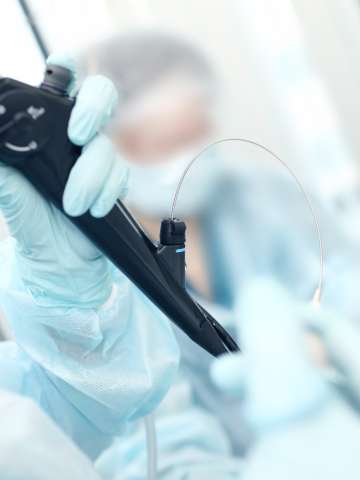Interventional Endoscopy
As leaders in interventional endoscopy, we diagnose and treat a wide range of GI conditions using the latest technology and minimally invasive procedures.

Why choose UCLA Health for interventional endoscopy?
Our expert team is recognized as national and international leaders in developing new technologies and techniques to diagnose and treat a wide range of GI disorders.
Highlights of our services include:
Multispecialty approach: Our skilled interventional endoscopists work closely with surgeons, medical oncologists, radiologists and pathologists. We partner with specialists across the health system including at the UCLA Agi Hirschberg Center for Pancreatic Diseases and the UCLA Robert G. Kardashian Center for Esophageal Health. We also work with experts at the UCLA Health Jonsson Comprehensive Cancer Center and the UCLA Medical Weight Management Program.
Latest technology: Our team uses sophisticated technology, tools and therapies. We combine our expertise with advanced technology to properly diagnose and treat patients.
Coordinated care: At our integrated clinics, you have access to multiple specialists under one roof who meet regularly to discuss your care and determine the best course of treatment. We work with a dedicated team of nurse practitioners and nurses to offer efficient, seamless care.
Commitment to research: Both in the laboratory and through clinical trials, our experts are constantly testing and implementing new technologies. We pioneer techniques that propel this rapidly growing field forward. Our team sets guidelines that define and advance the standard of care throughout the country.
Our areas of care
As experts in interventional endoscopy, we use advanced technologies to diagnose and treat many GI diseases. We specialize in:
Precise diagnosis
Using the latest technology, our interventional endoscopists can quickly establish a diagnosis. We're skilled at diagnosing a variety of gastrointestinal disorders.
Minimally invasive treatments
Our procedures are minimally invasive, meaning we perform them using thin, flexible tubes inserted through openings in your body, like the mouth or rectum. These procedures don't require external incisions, and recovery time is faster than with traditional surgery. By combining advanced imaging techniques and sophisticated devices with technical expertise, we help patients avoid more invasive surgical treatments.
Conditions we treat using endoscopy
Our interventional endoscopists can diagnose and treat many GI disorders including:
Achalasia: This condition causes trouble swallowing due to a spasm of the lower esophageal sphincter.
Acid reflux/gastroesophageal reflux disease (GERD): Stomach acid can flow back into the esophagus and contribute to heartburn, regurgitation, esophagitis and strictures. It can also lead to Barrett's esophagus, esophageal cancer and other symptoms and conditions.
Barrett's esophagus: The lining of the esophagus changes due to chronic acid reflux. Untreated, Barrett's esophagus can develop into esophageal cancer.
Bile duct diseases: These diseases affect the bile duct system, which carries bile (fluid that helps digest fat) from your liver to your intestines. We diagnose and treat bile duct stones (choledocholithiasis), strictures, cancer (cholangiocarcinoma) and other conditions.
Colon and rectal diseases: These include cancer, colon polyps and rectal polyps (abnormal tissue growths that can eventually become cancer). Our team typically treats larger polyps or early cancers found on screening exams.
Difficulty swallowing (dysphagia): This disorder can result from many conditions, including problems with muscle function, structural problems or GERD.
Esophageal cancer: We have a variety of therapies to prevent esophageal cancer, treat it early or help manage it, no matter the stage.
Esophageal stricture: This is a narrowing of the esophagus that results from chronic inflammation and scarring. Strictures can make it difficult or painful for food to pass down when swallowing.
Gallbladder diseases: These include gallstones, infection (cholecystitis) and cancer of the gallbladder.
Pancreatic diseases: These include pancreatitis (inflammation of the pancreas), pancreatic cysts and pancreatic cancer. We also treat pseudocysts, which are benign (noncancerous) cysts that can cause serious health problems if they rupture (tear).
Stomach (gastric) diseases:These diseases include gastric cancer, gastric polyps, gastric varices (dilated veins in the stomach), and bleeding. We also treat gastroparesis (slow emptying of the stomach).
Zenker's diverticulum: This condition causes an abnormal pocket to form on the wall of the upper part of the esophagus. It causes difficulty swallowing and a feeling of food being stuck in the throat.
Treatments we offer
Using state-of-the-art technology, we perform minimally invasive endoscopy procedures to treat a range of gastrointestinal conditions. We deliver these treatments using advanced techniques and unmatched expertise. Our experts specialize in:
Interventional endoscopy procedures
Our experts perform the following procedures:
Argon plasma coagulation (APC): APC cauterizes (burns) tissue in the gastrointestinal tract to treat bleeding from vascular malformations or to shrink tumors in the GI tract.
Capsule endoscopy (PillCam™): You swallow a tiny camera that moves through your digestive tract and takes pictures over several hours. The images show inflammation (swelling), bleeding and other signs of disease. You safely pass the PillCam with your stool. Capsule endoscopy can identify sources of blood loss from the GI tract and tumors or polyps of the small bowel. It can also look for inflammatory conditions such as Crohn's disease.
Celiac plexus block/neurolysis: We use this procedure to relieve pain associated with chronic pancreatitis and pancreatic cancer. After identifying the source of pain, we inject medications to reduce the pain sensation.
Cholangioscopy: Cholangioscopy uses tiny cameras to help your doctor see the bile ducts, biopsy bile duct strictures and tumors, or break up large bile duct stones (e.g. lithotripsy).
Chromoendoscopy: This procedure uses specialized light filters and dyes to highlight pre-cancerous growths and early cancers which can be difficult to see.
Colon polyp and cancer removal: For large polyps and early cancers in the colon and rectum, we use minimally invasive techniques such as endoscopic mucosal resection (EMR), endoscopic submucosal dissection (ESD) and endoscopic full thickness resection (EFTR). These techniques provide early treatment and to help you avoid surgery.
Cryotherapy: This procedure uses extreme cold to remove or shrink diseased tissue in the GI tract. Cryotherapy has been used in the treatment of and .
Dilation of strictures: A stricture is a narrowing in the GI tract that may cause symptoms of blockage. We perform dilation using specialized balloons or other devices that gradually stretch the narrowed area during an endoscopy.
Drainage of pancreatic pseudocysts and walled-off necrosis: Our team performs pseudocyst drainage by passing stents or drainage tubes through the wall of the stomach or small intestine into the abdominal area. To guide the procedure, we use EUS and sometimes fluoroscopy (moving X-rays).
Endoscopic retrograde cholangiopancreatography (ERCP): This advanced endoscopic technique examines and treats disorders of the bile duct and and pancreatic duct. We pass small catheters through a long, flexible tube into the ducts. Our team uses ERCP to break down or remove stones and relieve blockages. We can also place temporary or permanent stents to drain digestive fluids.
Endoscopic ultrasound (EUS): EUS combines traditional endoscopy with ultrasound imaging. A miniature ultrasound transducer at the tip of an endoscope allows your doctor to see a broad range of structures in the digestive tract, from the esophagus to the rectum. We use EUS to perform fine-needle aspiration or biopsy (FNA/FNB). It also helps us drain cysts, place stents, inject medications and perform other advanced techniques.
Enteral/intestinal stenting: Advanced tumors, radiation therapy, and gastrointestinal surgery may cause narrowing of the GI tract. This narrowing can lead to problems such as , pain, vomiting and malnutrition. We use permanent and removable enteral stents to keep the GI tract open.
Enteroscopy: To evaluate the small bowel, we use a long, thin, flexible tube with a small camera on the end. Deep enteroscopy (e.g., single-balloon or double-balloon enteroscopy) uses specialized equipment to navigate through the length of the small bowel. We use these tools to look at sources of bleeding or treat polyps and tumors.
Gastric peroral endoscopic myotomy (G-POEM): This procedure treats gastroparesis by making an incision in a tight muscle at the end of the stomach (pylorus).
Peroral endoscopic myotomy (POEM): This procedure uses a tiny knife to release tight muscles in the esophagus that cause swallowing difficulties. does not require external incisions.
Radiofrequency ablation (RFA): This treatment uses heat to destroy abnormal cells on the surface of the GI tract, usually due to Barrett's esophagus.
Stone removal: We use ERCP to extract stones. Your doctor may recommend lithotripsy and cholangioscopy to break up and extract larger stones in the bile duct or pancreas duct. Stones may cause blockage, leading to pain and occasionally, a life-threatening infection known as cholangitis.
Transoral incisionless fundoplication (): This minimally invasive treatment for does not require incisions. We perform TIF using endoscopy. The procedure offers fast recovery, requires no metal implants, and helps restore the anti-reflux “valve” between the esophagus and stomach. It improves symptoms and reduces or eliminates the need for anti-reflux medications.
Zenker's diverticulum septotomy: We use a specialized needle knife to incise the septum of the diverticulum. This procedure relieves dysphagia, or difficulty swallowing, associated with .
Non-surgical treatments for obesity
We are a high-volume center for nonsurgical weight loss procedures. These procedures are minimally invasive, require no external incisions, and help you lose weight. We work in partnership with bariatric surgeons and medical weight loss experts. Our weight loss procedures include:
: This procedure decreases the size of the stomach without the need for any incisions. We perform this technique using the OverStitch™ System. We insert a device with tiny tools through the mouth and use the tools to fold the stomach into a sleeve-like shape.
: This procedure helps people who have regained weight after gastric bypass surgery. The TORe procedure gets the weight loss process back on track by tightening the pouch if it has stretched out after the original surgery.
: The endoscopic sleeve gastroplasty (ESG) procedure can help patients who previously had a laparoscopic sleeve gastrectomy surgery (vertical sleeve gastrectomy). It makes the stomach smaller if it stretched out following surgery.
Our nonsurgical weight loss techniques can help people who do not qualify for traditional bariatric surgery and those who feel that surgery is not right for them. We can also treat people who have gained weight or had complications after prior weight loss surgery. Nonsurgical procedures allow these patients to avoid another operation.
Meet our team
Our dedicated team includes internationally recognized leaders in interventional endoscopy. We use advanced technology to diagnose and treat a range of GI disorders.
Contact us
Call to connect with a specialist.
Find your care
Our expert interventional endoscopy team includes skilled physicians who perform minimally invasive endoscopic procedures to treat GI disorders. Call to connect with a specialist.
